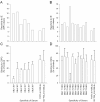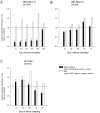Several domains from VAR2CSA can induce Plasmodium falciparum adhesion-blocking antibodies
- PMID: 20064234
- PMCID: PMC2817698
- DOI: 10.1186/1475-2875-9-11
Several domains from VAR2CSA can induce Plasmodium falciparum adhesion-blocking antibodies
Abstract
Background: Malaria caused by Plasmodium falciparum can result in several different syndromes with severe clinical consequences for the about 200 million individuals infected each year. During pregnancy, women living in endemic areas become susceptible to malaria due to lack of antibodies against a unique P. falciparum membrane protein, named VAR2CSA. This antigen is not expressed in childhood infections, since it binds chondroitin sulphate A (CSA) expressed on the intervillous space in the placenta. A vaccine appears possible because women acquire protective antibodies hindering sequestration in the placenta as a function of parity. A challenge for vaccine development is to design small constructs of this large antigen, which can induce broadly protective antibodies. It has previously been shown that one domain of VAR2CSA, DBL4-FCR3, induces parasite adhesion-blocking antibodies. In this study, it is demonstrated that other domains of VAR2CSA also can induce antibodies with inhibitory activity.
Methods: All VAR2CSA domains from the 3D7 and HB3 parasites were produced in Baculovirus-transfected insect cells. Groups of three rats per protein were immunized and anti-sera were tested for surface reactivity against infected erythrocytes expressing FCR3 VAR2CSA and for the ability to inhibit FCR3CSA parasite adhesion to CSA. The fine specificity of the immune sera was analysed by VAR2CSA peptide arrays.
Results: Inhibitory antibodies were induced by immunization with DBL3-HB3 T1 and DBL1-3D7. However, unlike the previously characterised DBL4-FCR3 response the inhibitory response against DBL1-3D7 and DBL3-HB3 T1 was poorly reproduced in the second rounds of immunizations.
Conclusion: It is possible to induce parasite adhesion-blocking antibodies when immunizing with a number of different VAR2CSA domains. This indicates that the CSA binding site in VAR2CSA is comprised of epitopes from different domains.
Figures



Similar articles
-
Var2CSA DBL6-epsilon domain expressed in HEK293 induces limited cross-reactive and blocking antibodies to CSA binding parasites.Malar J. 2008 Sep 4;7:170. doi: 10.1186/1475-2875-7-170. Malar J. 2008. PMID: 18771584 Free PMC article.
-
Induction of strain-transcendent antibodies to placental-type isolates with VAR2CSA DBL3 or DBL5 recombinant proteins.Malar J. 2011 Feb 11;10:36. doi: 10.1186/1475-2875-10-36. Malar J. 2011. PMID: 21314945 Free PMC article.
-
Induction of adhesion-inhibitory antibodies against placental Plasmodium falciparum parasites by using single domains of VAR2CSA.Infect Immun. 2009 Jun;77(6):2482-7. doi: 10.1128/IAI.00159-09. Epub 2009 Mar 23. Infect Immun. 2009. PMID: 19307213 Free PMC article.
-
Designing a VAR2CSA-based vaccine to prevent placental malaria.Vaccine. 2015 Dec 22;33(52):7483-8. doi: 10.1016/j.vaccine.2015.10.011. Epub 2015 Nov 26. Vaccine. 2015. PMID: 26469717 Free PMC article. Review.
-
Progress and Insights Toward an Effective Placental Malaria Vaccine.Front Immunol. 2021 Feb 25;12:634508. doi: 10.3389/fimmu.2021.634508. eCollection 2021. Front Immunol. 2021. PMID: 33717176 Free PMC article. Review.
Cited by
-
A new method for sequencing the hypervariable Plasmodium falciparum gene var2csa from clinical samples.Malar J. 2017 Aug 17;16(1):343. doi: 10.1186/s12936-017-1976-8. Malar J. 2017. PMID: 28818101 Free PMC article.
-
Identification and characterization of B-cell epitopes in the DBL4ε domain of VAR2CSA.PLoS One. 2012;7(9):e43663. doi: 10.1371/journal.pone.0043663. Epub 2012 Sep 6. PLoS One. 2012. PMID: 22970138 Free PMC article.
-
mSphere of Influence: Structural Insights into the Molecular Mechanism Underlying Placental Malaria.mSphere. 2021 Jun 30;6(3):e0039121. doi: 10.1128/mSphere.00391-21. Epub 2021 May 28. mSphere. 2021. PMID: 34047650 Free PMC article.
-
Antibodies to a full-length VAR2CSA immunogen are broadly strain-transcendent but do not cross-inhibit different placental-type parasite isolates.PLoS One. 2011 Feb 7;6(2):e16622. doi: 10.1371/journal.pone.0016622. PLoS One. 2011. PMID: 21326877 Free PMC article.
-
Influence of Intermittent Preventive Treatment on Antibodies to VAR2CSA in Pregnant Cameroonian Women.Am J Trop Med Hyg. 2016 Mar;94(3):640-9. doi: 10.4269/ajtmh.15-0521. Epub 2015 Dec 28. Am J Trop Med Hyg. 2016. PMID: 26711513 Free PMC article.
References
-
- Baruch DI, Pasloske BL, Singh HB, Bi X, Ma XC, Feldman M, Taraschi TF, Howard RJ. Cloning the P. falciparum gene encoding PfEMP1, a malarial variant antigen and adherence receptor on the surface of parasitized human erythrocytes. Cell. 1995;82:77–87. doi: 10.1016/0092-8674(95)90054-3. - DOI - PubMed
-
- Smith JD, Chitnis CE, Craig AG, Roberts DJ, Hudson-Taylor DE, Peterson DS, Pinches R, Newbold CI, Miller LH. Switches in expression of Plasmodium falciparum var genes correlate with changes in antigenic and cytoadherent phenotypes of infected erythrocytes. Cell. 1995;82:101–110. doi: 10.1016/0092-8674(95)90056-X. - DOI - PMC - PubMed
Publication types
MeSH terms
Substances
LinkOut - more resources
Full Text Sources
Other Literature Sources

